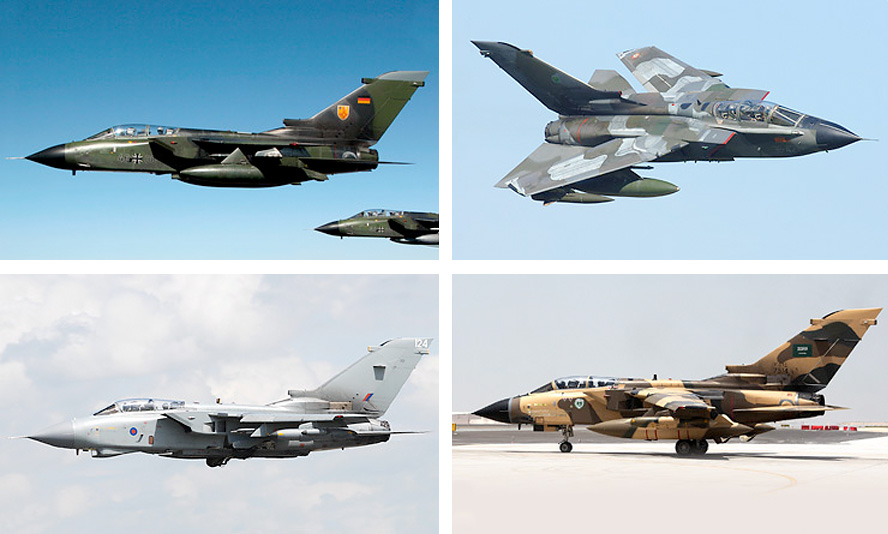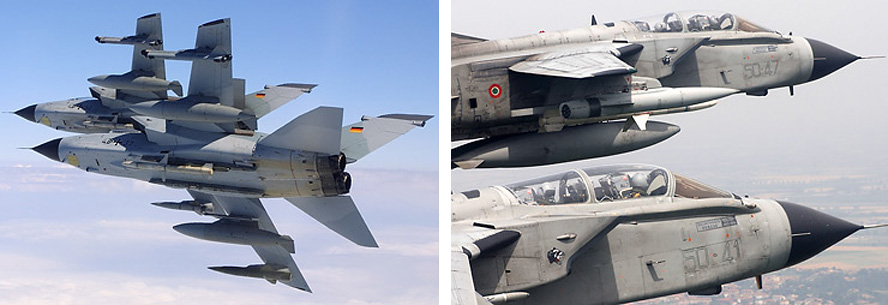Variants
The Tornado concept offers a common air vehicle with a family of mission variants optimised for different roles. This approach is enabled by a range of unique design features and yields the logistics, training and the cost benefits of a single aircraft type, but with the combat effectiveness of a range of specialised equipment. Three primary variants have been developed:
Tornado IDS (Interdiction Strike) carries out air-to-ground attack missions, maritime strike and tactical reconnaissance.
This is the core version of the Tornado and was adopted, with some variations in detail, by all the Air Forces of the Partner Nations of the consortium, and the Royal Saudi Air Force.
This was the first European military aircraft to be designed with fly-by-wire flight controls and specialised for ground attack, although also capable of conducting anti-shipping and reconnaissance missions at extremely low altitudes.
The RAF identified the attack version as the GR.Mk.1, while the other Air Forces operators retained the original IDS designation. The only significant difference between the aircraft constructed for the three nations was that the British GR.Mk.1 incorporated an extra fuel tank in the tail fin. The RAF subsequently developed two further specific variants, the GR.Mk.1A, optimised for photo-electronic reconnaissance, and the GR.Mk1B, dedicated to the anti-shipping role. The latest version that was serving with the RAF is the GR.Mk.4, the first prototype of which first flew in May 1993, and which has today completely replaced all the preceding versions flown in the RAF. Furthermore the German and Italian Tornado aircraft were equipped with dedicated reconnaissance pods. Subsequently the Marineflieger and Aeronautica Militare introduced the required modifications to allow their Weapon System to operate the Kormoran anti-ship missile. Like the RAF, both Luftwaffe and Aeronautica Militare initiated Mid Life Upgrade programmes for the modernisation of their fleet, extending the operational life of the aircraft until potentially 2035 with improving the capabilities of the aircraft to adapt to modern cockpit ergonomics, displays, computing, communications, counter-measures and precision weapons technology.
745 Tornado IDS aircraft including trainers were manufactured as follows:
- 228 - ROYAL AIR FORCE
- 210 - LUFTWAFFE
- 112 - MARINEFLIEGER
- 99 - AERONAUTICA MILITARE
- 96 - ROYAL SAUDI AIR FORCE

Tornado ECR (Electronic Combat and Reconnaissance) has the electronic warfare equipment and weapons for the suppression of enemy air defences and for electronic and tactical reconnaissance, whilst retaining all the capabilities of the Tornado IDS.
This specialised version of the Tornado is only operated within the Air Forces of Germany and Italy. It was developed specifically for reconnaissance and the location and suppression of enemy anti-aircraft systems. The formulation of the German requirement was dated in the early Eighties, and resulted in a Luftwaffe order for 35 new build aircraft in 1986. Deliveries continued until 28th January 1992, when the 35th and final example was handed over, the aircraft also being the last of the 357 aircraft manufactured by MBB. The Italian ECR configuration was very close to the ECR German aircraft configuration, with Italy deciding to have 16 IDS aircraft converted to the ECR avionic and weapons fit. The first aircraft was delivered on 07th April 1998.
51 Tornado ECR aircraft were produced as follows:
- 35 - LUFTWAFFE
- 16 - AERONAUTICA MILITARE

Tornado ADV (Air Defence Variant) allows Beyond Visual Range (BVR) autonomous or integrated air defence and close range air-to-air combat.
The specific needs of the UK in defending large stretches of airspace particularly to the north of the islands, involved securing an air defence capability with excellent endurance (combat air patrol) capabilities and modern stand-off air-to-air missile armament. In response to this uniquely UK air staff requirement, Panavia developed a specialised fighter version, slightly adapted to manoeuvring combat but with excellent capabilities for long range interception. The use of the GEC Marconi FOXHUNTER radar engendered a re-design of the forward section of the fuselage, which became more streamlined and 1, 36 meters longer. The underside was modified to permit the installation of four Sky Flash radar guided missiles; for this reason, a 53 cm long fuselage add-on was inserted behind the nose wheel bay, thus avoiding the requirement to move the housing for the nose gear, with the installation of a retractable refuelling hose on the left-hand-side of the aircraft. To enhance range and ‘loiter’ capability, the left-hand cannon was removed to facilitate the installation of an additional fuel tank allowing the additional accommodation of around 900 litres of fuel. The ADV first flight took place on 27th of October 1979, while the first production delivery flew on 04th March 1984. Two sub-versions of the ADV were produced, the first designated F2 comprised an initial batch of 18 aircraft equipped with an interim version of the radar – two of them as dual control trainer versions – and were delivered by November 1984. The definitive production version, designated F3, entered service in November 1985.
194 Tornado ADV aircraft were manufactured, as follows:
- 170 - ROYAL AIR FORCE
- 24 - ROYAL SAUDI AIR FORCE



